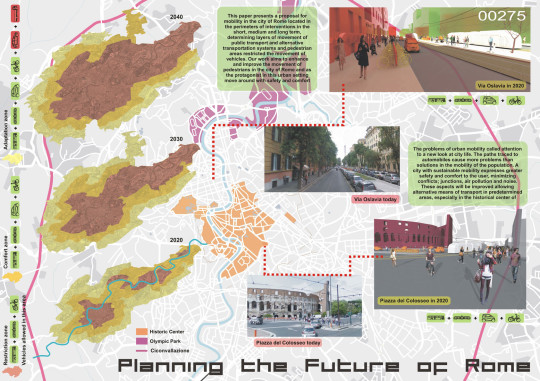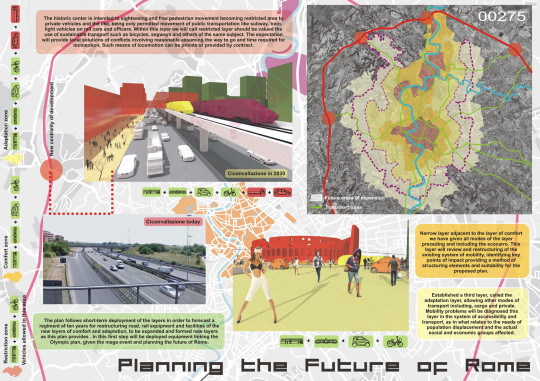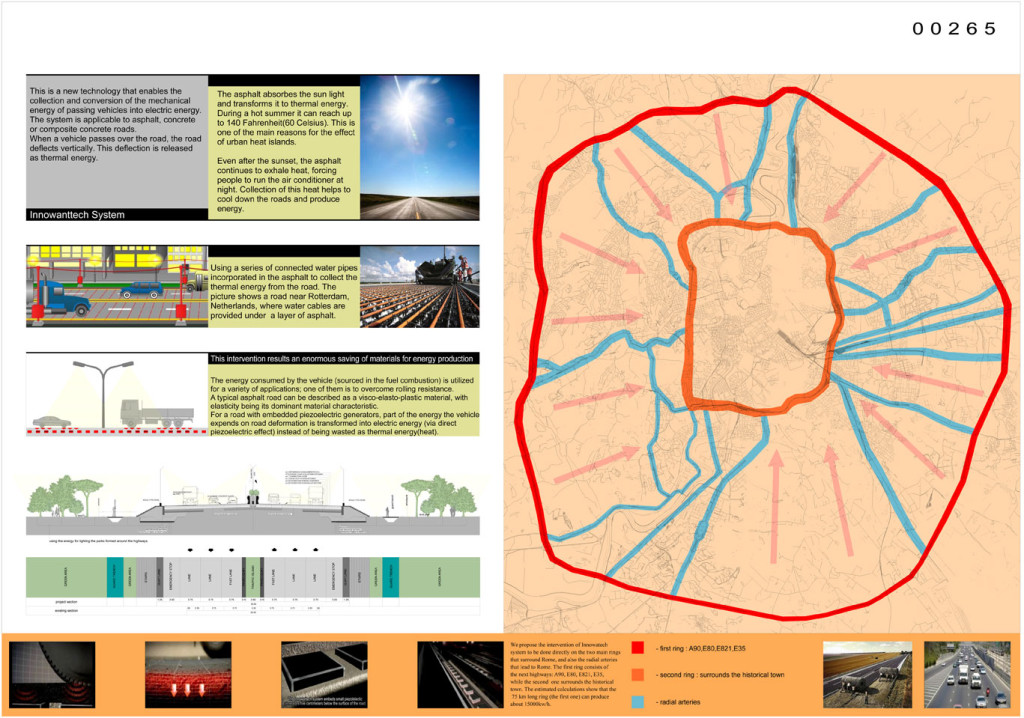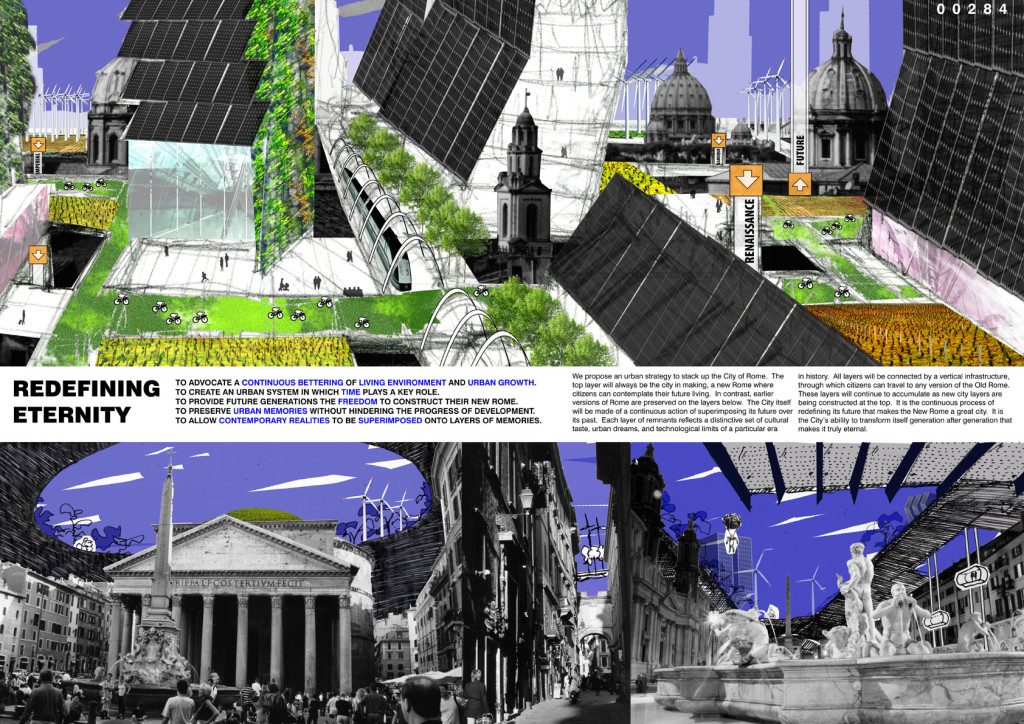Info:
Title: Planning the future of Rome - Code: 00275Contest: Rome / 2010
By: E.J. Vieira / J.F.X. Magalhães / Ricardo da Silva Hatiw Lu / Carlos da Costa Ferreira / G.A. Pauli / L. Vista / Marcus Vinícius de Brito / Reginaldo Maciel de Oliveira Filho / Ronaldo Amaro de Oliveira / Vanessa Horita Oliveira
Views: 11843 Likes: 13
Votes:
JUERGEN MAYER H. 0 FRANCESCO LIPARI2 FELIPE ESCUDERO1 FRANCESCO GATTI 6 MICHAEL CATON 42.6
Planning the future of Rome


Rome
It is known thatRome arose on the banks of theTiber river, a few miles from the coast and strategic point: passing by a route that linked the coast inland. The town was ruled by kings for a long time. His village was formed by people from different backgrounds with a strong influence of the Etruscans, who were in the area until the founding of the republic. Rome inherited the Etruscans gladiatorial games, fighting between fighters. Giving rise to the republican regime, where men were soldiers, responsible citizenship. Rome conquering other territories through war, then became known as theRoman empire. That empire had contributions in different fields: as in law, especially in art and architecture with great monuments preserved to this day.
The Roman architecture was modeled on the Greek architecture, and constituted an example of influence of technological development. These features covering architectural features Greek and Roman Classical Architecture call.
Known and recognized asRomethe eternal city for its historical value and most important cultural legacies left by more than two thousand years.
Olympics
Rome isEurope’s potential candidate to host the summer Olympics 2020. It has high approval ratings in public opinion polls compiled seconds. The requirements are being studied to provide equipment for competitions, facilities, tourism and infrastructure improvements in the historic city of culture. Rome brings experience in implementing the 1960 Olympics and offers some new equipment for the realization of events and ensuring easy movement on the perimeter Olympian, as well as the mobility in the historic city.
The way of the city
Urge the formulation of an alternative urban planning. Therefore one must excel in the conformation of a social legacy consists of a set of tangible and intangible assets that contribute to the creation of urban improvements.
In this sense, the social legacy to be pursued by urban managers must submit a summary of the main challenges to be overcome in the host city’s sporting mega event.
Actions designed to improve both for the production of public spaces are essential in this scenario. There is scope for generation of legacies in the expansion of the potential mobility of city dwellers, the generation of mechanisms to reduce conflicts and urban violence even in the production of territorial identities promoters of humanizing experiences.
The problems of urban mobility called attention to a new look at city life. The paths traced to automobiles cause more problems than solutions in the mobility of the population. A city with sustainable mobility expresses greater safety and comfort to the user, minimizing conflicts; junctions, air pollution and noise. These aspects will be improved allowing alternative means of transport in predetermined areas, especially in the historical center ofRome, the Olympic and regions most affected by the conflicts mentioned.
The historic center is intended to sightseeing and free pedestrian movement becoming restricted area to private vehicles and the like, being only permitted movement of public transportation like subway, train, light vehicles on rail cars and officers. Within this layer we will call restricted layer should be valued the use of sustainable transport such as bicycles, segways and others of the same subject. The expectation will provide local solutions of conflicts involving reasonable assuming the way to go and time required for locomotion. Such means of locomotion can be private or provided by contract.
Narrow layer adjacent to the layer of comfort we have given all modes of the layer preceding and including the ecocar. This layer will review and restructuring of the existing system of mobility, identifying key points of impact providing a method of structuring elements and suitability for the proposed plan.
Established a third layer, called the adaptation layer, allowing other modes of transport including, cargo and private. Mobility problems will be diagnosed this layer in the system of accessibility and transport, as in what relates to the needs of population displacement and the actual social and economic groups affected.
The plan follows short-term deployment of the layers in order to forecast a regiment of ten years for restructuring road, rail equipment and facilities of the new layers of comfort and adaptation, to be expanded and formed new layers as this plan provides. In this first step will be deployed equipment linking the Olympic plan, given the mega event and planning the future ofRome.
Expanding the periodic layers in each decade with the new facilities and equipment adjustments and restructuring of successive layers, thus tending to touch the ciconvallazione. It has as objective that the main transport lines, and the existing building meet at strategic, historical and link to circovallazione and allows easy movement through the city ofRomewith modal system carrying passengers which is to your interest: tourism, course of study, or ride.
We take as criterion the lines of public transport mass, areas of great historical value and topography to delineate the layers of the urban plan of sustainable mobility, distant one thousand and five hundred meters from the main line of transport, offering as useful space for movement of the shaft adjacent and served transport alternative to the aforementioned strategic points and stops mainly in departures and arrivals of these lines. This definition takes into account a comfortable time with the use or non-smooth transport (pedestrian or bicycle).
The characterization of long-term plan aims at improving the urban environment and impacts of the automobile left the city by bringing a joint multimodal, encouraging sustainable transport causing the calling of new systems and developments in the industry. However, a significant visual improvement, noise, air quality and minimize claims. The urban intervention plan is developed alongside the Olympic emphasizing mobility during the events ofRome and planning a future, attracting tourism with conceptual richness and legacy after the Olympics.
Info:
Title: Planning the future of Rome
Time: 16 marzo 2010
Category: Rome
Views: 11843 Likes: 13
Tags: -






